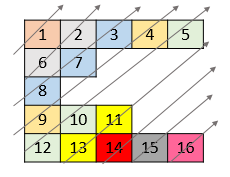Given a list of lists of integers, nums, return all elements of nums in diagonal order as shown in the below images.
Input: nums = [[1,2,3],[4,5,6],[7,8,9]] Output: [1,4,2,7,5,3,8,6,9]
Input: nums = [[1,2,3,4,5],[6,7],[8],[9,10,11],[12,13,14,15,16]] Output: [1,6,2,8,7,3,9,4,12,10,5,13,11,14,15,16]
Input: nums = [[1,2,3],[4],[5,6,7],[8],[9,10,11]] Output: [1,4,2,5,3,8,6,9,7,10,11]
Input: nums = [[1,2,3,4,5,6]] Output: [1,2,3,4,5,6]
1 <= nums.length <= 10^51 <= nums[i].length <= 10^51 <= nums[i][j] <= 10^9- There at most
10^5elements innums.
# @param {Integer[][]} nums
# @return {Integer[]}
def find_diagonal_order(nums)
num_row_col = []
for row in 0...nums.length
for col in 0...nums[row].length
num_row_col.push([nums[row][col], row, col])
end
end
num_row_col.sort_by! {|nrc| nrc[2]}
num_row_col.sort_by! {|nrc| nrc[1] + nrc[2]}
return num_row_col.map {|nrc| nrc[0]}
end
